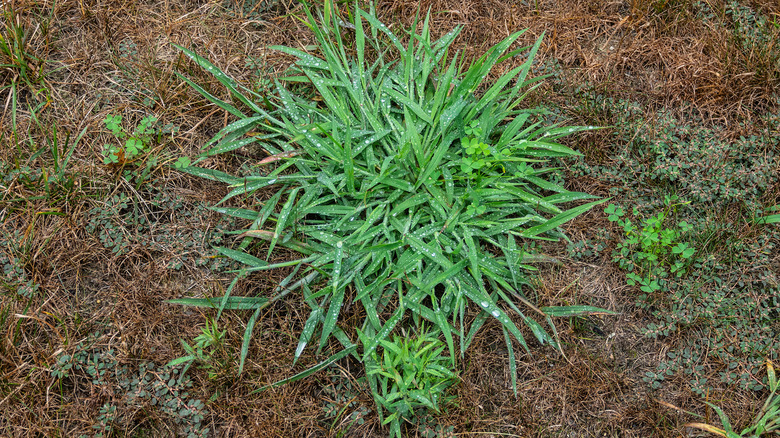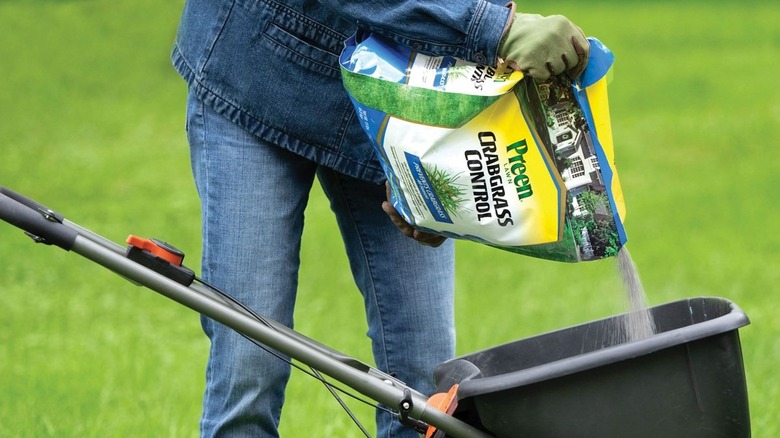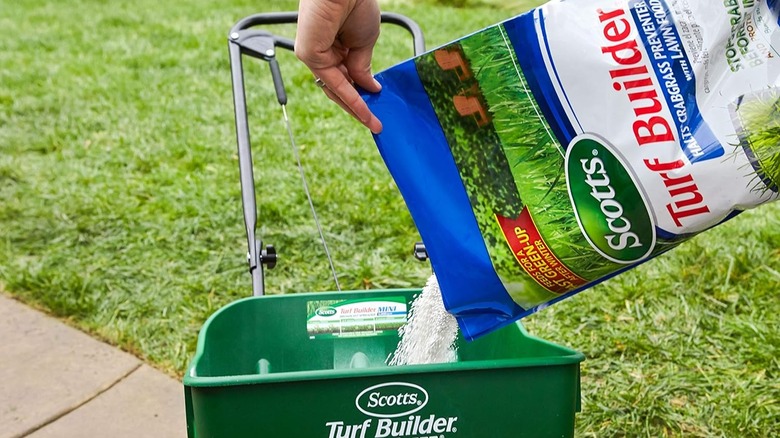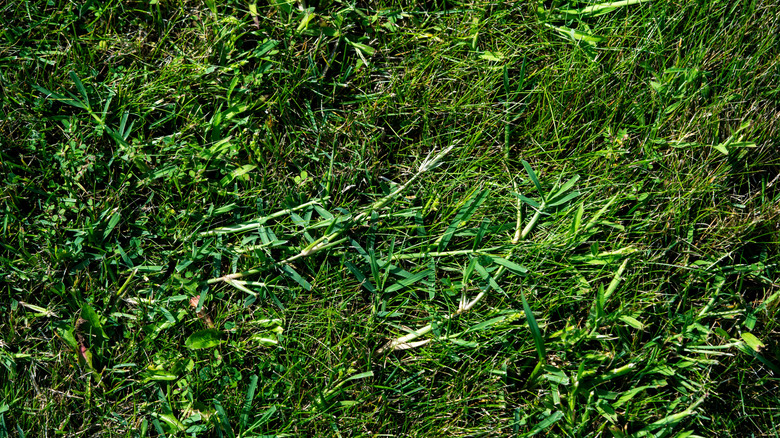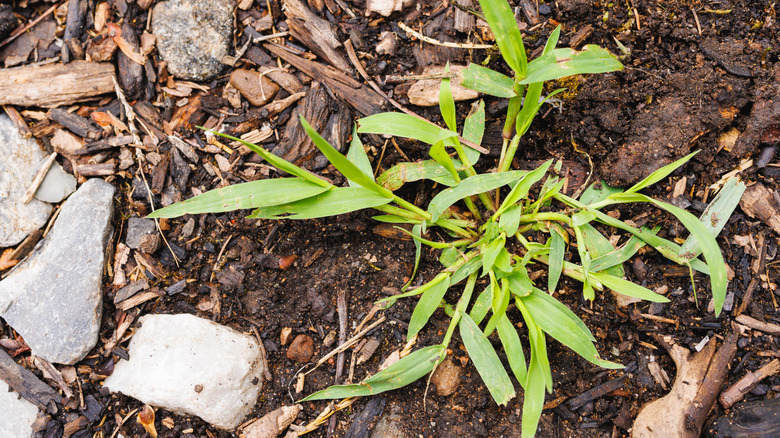The Best Crabgrass Weed Killer Products To Consider (& Which To Avoid Buying)
We may receive a commission on purchases made from links.
Crabgrass (Digitaria spp.) is like a gremlin from an '80s movie, happily tearing about your lawn and creating complete chaos in your turfgrass and whatever plans you have for a luxurious lawn. It's difficult to manage not because of how hard crabgrass is to kill, but because you have to start the removal process in a certain order and at a certain time to be effective. We sifted through expert guidance and consumer reviews to identify which products are most likely to help you rid yourself of this gremlin, like Quinclorac and Scotts Halts, and along the way, we ran across a few you might want to avoid, such as BioAdvanced and AgraLawn crabgrass killer products.
Of course, applying chemicals isn't the only, or even the most important, aspect of ridding your lawn of crabgrass. Experts point to critical cultural practices that are important for managing crabgrass. These include maintaining a dense crop of the turfgrass of your choice by properly seeding, mowing, and caring for it. But when the time comes to apply a crabgrass-killing product, you'll run into two basic sorts: pre-emergent treatments that destroy crabgrass before or shortly after germination, and post-emergent treatments that target and kill the weed itself. Some products claim to do both, and in many cases, the reviewers tend to agree. They're applied at different times and in different ways, and we'll show you the right way to do it.
Preen Crabgrass Control
Dithiopyr — or Dimethyl 2-(difluoromethyl)-4-(2-methylpropyl)-6-(trifluoromethyl)pyridine-3,5-dicarbothioate if you prefer, but you don't — is a pre-emergent herbicide most often associated with a product called Dimension. But it's also the active ingredient in Preen's Crabgrass Control product. Dithiopyr works by inhibiting the growth of root cells, making it impossible for germinated seeds to grow. It also works as an early post-emergent, effectively stopping the growth of very young crabgrass plants, so the product is described as both a pre- and post-emergent, though it doesn't necessarily function as well as dedicated post-emergents might. It can also inhibit root growth for your turfgrass, so it's best used on a healthy, well-established lawn.
Because it functions as both a pre- and post-emergent herbicide, it has also kept Preen popular, even though its reviews are sometimes lukewarm. It has 4 stars on Amazon, but detractors say it had no effect on their crabgrass problem. One possible explanation for this is that the product was being applied to plants too late in the season or to plants too mature for it to act on effectively. One reviewer noted that Preen isn't a crabgrass killer but a preventer. The implication is that this product, even as a sometimes post-emergent treatment, isn't meant to deal with a lawn full of mature crabgrass plants. Another reviewer reported that their lawn went from 40% crabgrass to crabgrass-free after two early-spring applications when Preen should be most effective.
Scotts Halts
Scotts Turf Builder Halts crabgrass preventer has a somewhat awkward name that would suggest it's primarily a pre-emergent treatment for crabgrass. But its active ingredient, pendimethalin, is a pre- and early post-emergent herbicide for both broadleaf and grassy weeds. It works by preventing cell elongation, thereby stopping shoot and root growth. Pendimethalin is generally described as a killer of annual grasses like crabgrass. Pendimethalin is sometimes combined with post-emergence herbicides like quinclorac and fenoxaprop-p-ethyl for controlling late-season weed germination.
Scotts Halts had the best reviews of all the products we considered, scoring 4.5 stars for over 4,700 Amazon reviews. A small number of reviewers complained that it killed their turfgrass but didn't eliminate the crabgrass, but most were very happy with its performance. Many experts agree that pre-emergent treatment is more important and effective than post-emergent treatment when it comes to crabgrass, so Scotts Halts might be the best choice for many consumers. It's worth noting that Scotts Turf Builder Halts includes a fertilizer component, as do many crabgrass-control products. Scotts explains this as a way to help your lawn "green up" faster in early spring, but it also helps in the fight against crabgrass because a healthy lawn of turfgrass is the most reliable way to permanently squeeze out the weed.
Quinclorac/BASF Drive XLR8
Quinclorac might be the best-known and easiest post-emergent solution to crabgrass. It is present in at least 16 consumer and institutional products, and was represented in our review by more products than any other chemical. While pre-emergents are applied to an entire area where crabgrass seeds might exist, post-emergents are applied to growing plants. Quinclorac is an auxin herbicide that was developed to selectively target crabgrass. Auxin herbicides mimic the activity of a plant hormone and result in all manner of deformation and deficiency in the targeted plants. Auxins were traditionally thought to only affect broadleaf weeds, not grasses. Since it's primarily used as a post-emergent herbicide, it is sometimes combined with pendimethalin for treating late-emerging weeds.
Reviews of quinclorac products are overwhelmingly positive, with the exception of a single formulation by Liquid Harvest that was described as ineffective by more than a quarter of reviewers. Reviewers for other quinclorac products, including BASF Drive XLR8 and competitors, found quinclorac effective for controlling both crabgrass and clover. Take care with Kentucky bluegrass and fescue lawns, which can be damaged if package directions aren't followed carefully.
Consider avoiding BioAdvanced Crabgrass Killer for Lawns
While some BioAdvanced products are quite popular, reviewers were not as happy with two of the brand's sprays. In the apparent standard of the industry, they have similar names: BioAdvanced crabgrass killer for lawns and BioAdvanced all in one lawn weed & crabgrass killer. The latter has a staggering 27% of one-star reviews on Amazon, but that's only for a handful of reviews. And it's worth noting that the liquid concentrate version of the all-in-one treatment gets 4.4 stars on Amazon. In any event, it seems reasonable to discard such a small number of ratings. Unfortunately, the former, BioAdvanced crabgrass killer for lawns, received 3.4 stars for nearly 300 ratings — which is definitely enough reviews to draw a conclusion.
Interestingly, the two products have different active ingredients. BioAdvanced crabgrass killer for lawns is Fenoxaprop-p-ethyl, while the other uses quinclorac. Fenoxaprop-p-ethyl is a post-emergent treatment that BioAdvanced refers to as a "systemic herbicide." In the right circumstances, it can control annual grasses like crabgrass with only one application, but reviewers complain that it simply has no more than a very minor effect. One reviewer claims the problem is that the hose-attached sprayer doesn't dispense the right amount, but several others applied the product directly with no effect.
Steer clear of AgraLawn Crabgrass Killer
It's unfortunate when a product that smells so good works, or seems to work, poorly. Some reviewers of AgraLawn's crabgrass killer report that it smells like cinnamon toast. Indeed, its ingredients list reads like a slightly oddball pancake, including baking soda, wheat flour, cornmeal, cumin, and its active ingredient, cinnamon. AgraLawn claims it's a safe product, and that's probably true as far as selective post-emergent crabgrass herbicides go, though you shouldn't actually make pancakes from it. Unfortunately, however safe it is, reviewers also found it ineffective at killing or suppressing crabgrass, giving it 3.3 stars for nearly 200 reviews and noting that it had no effect on crabgrass even when the label directions were followed carefully.
Cinnamon essential oil has shown some promise as a germination inhibitor for some weeds, though not specifically for crabgrass, or even for annual grasses in general. Research from the Weed Technology journal shows that a similar product, Garden Weasel AG crabgrass killer (also containing sodium bicarbonate and cinnamon), was ineffective at removing mature crabgrass, and while baking soda is known to be a way to kill crabgrass naturally, the study also found that sodium bicarbonate alone is unacceptably damaging to turfgrass. It was, however, shown to be potentially effective against young crabgrass with only one or two leaves. But that particular product, unlike AgraLawn crabgrass killer, also contains corn gluten — which has been shown effective as a pre-emergent herbicide inhibiting germination.
